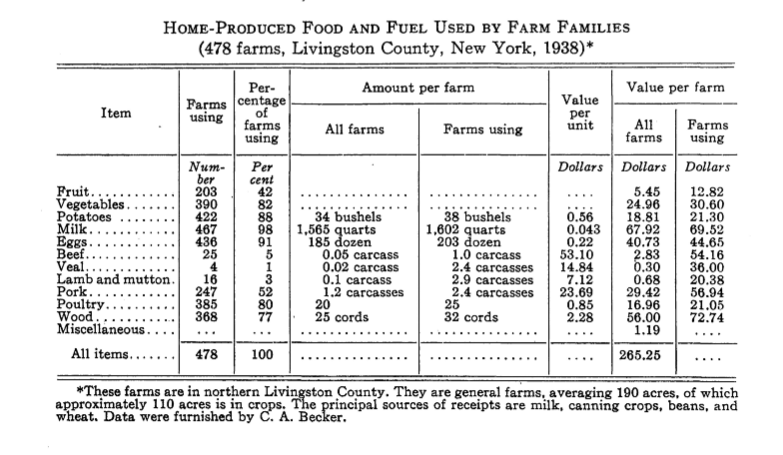In my previous post I defined The French Diet as a diet where the staples are starch and dairy fat.
Cornell Cooperative Extension produced a series of informational pamphlets in the thirties and forties with topics such as “The Clovers in New York” and “Simplifying Home Sewing”. You can peruse them in the Cornell Digital Library. One of those pamphlets was “Living Form The Farm“. Cooperative Extension agents polled people living on farms in upstate New York as to how much of the families’ food needs were produced from the farm as opposed to purchased and how much money that saved them. It was a study in home economics but it ended up being a VERY interesting snapshot of what farmers in rural America were actually eating from 1938-1940. Unfortunately its not a complete snapshot because it doesn’t include store bought food, but it’s still very telling.




Who was eating all of this?

This sounds like a lot of calories and fat but lets break it down on a daily basis. Since the 80 pounds of butter provided “some butter during part of the year” we can assume that butter consumption was MUCH higher. I’m going to guess based on the Soper family, also profiled in the publication, that average butter consumption in those days was about one pound per person per week.
| Food | Calories per Person Per Day | Fat per Adult Per Day |
| 2190 Quarts Jersey Milk (5% Fat) | 686 | 42 g |
| 365 Quarts Cream | 539 | 57 g |
| 1 Pound Butter per Week | 367 | 32 g |
| 365 Dozen Eggs | 160 | 10 g |
| 475 Pounds Pork | 369 | 37 g |
| 250 Pounds Beef | 166 | 13g |
| 50 Bushels potatoes | 333 | |
| Total Animal Products and Starch | 2620 | 191 g |
So that is 2600 calories and 191g of fat, mostly saturated, produced and consumed on the farm per man, woman and child (plus my assumption about purchased butter). This is a fascinating total because in my last post I talked about a dairying region in China where 186 grams of fat per day were being consumed in 1983. Different continent, different decade, same dietary pattern.
Living From The Farm also shows how widespread this dietary pattern was at the time. The appendix shows county by county the percentage of farms who kept dairy cows and who kept egg laying chickens, etc. Almost every farm at the time kept milk cows for home use.

Living From The Farm is the closest thing I know of to a quantified dietary survey of pre-WWII farm households. The diet of that time is discussed in great detail in cookbooks such as Smokehouse Ham, Spoon Bread and Scuppernong Wine, but this pamphlet is the only thing I’ve seen that really quatifies it.
